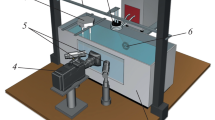Abstract
Relations are derived which enable one to assess the size of fragments of a liquid-metal droplet after its fragmentation formed in the case of instantaneous contact between a hot metal surface and a coolant. The obtained experimental data demonstrate that the amplitude of pressure pulses generated during vapor film collapse (second boiling crisis) is several times lower than the values required for triggering a spontaneous vapor explosion. The assumption is validated according to which progress in studying the process of triggering a spontaneous vapor explosion is associated primarily with advances in understanding the mechanism of fragmentation of individual droplet.
Similar content being viewed by others
References
Executive Summary of the CNSI Specialist Meeting on Fuel-Coolant Interactions. NUREG/CP-0127, Santa-Barbara, 1993.
Fletcher, D.F., Nucl. Eng. Des., 1995, vol. 155, p. 27.
Berthoud, G., Ann. Rev. Fluid Mech., 2000, vol. 32, p. 573.
Corradini, M., Nucl. Safety, 1991, vol. 32, p. 337.
Inoue, A. and Bankoff, S.G., J. Heat Transfer, 1981, vol. 103, p. 459.
Inoue, A., Aoki, S., Aritomi, M. et al., Study of Transient Heat Transfer of Film Boiling due to Arrival of a Pressure Shock, Proc. 7 th Int. Heat Transfer Conf., Munich, 1982, Paper FB 39.
Grigor’ev, V.S., Zhilin, V.G., Zeigarnik, Yu.A. et al., Teplofiz. Vys. Temp., 2005, vol. 43, no. 1, p. 100 (High Temp. (Engl. transl.), vol. 43, no. 1, p. 103).
Zhilin, V.G., Ivochkin, Yu.P., Oksman, A.A. et al., Teplofiz. Vys. Temp., 1996, vol. 34, no. 5, p. 811 (High Temp. (Engl. transl.), vol. 34, no. 5, p. 810).
Zeigarnik, Yu.A., Ivochkin, Yu.P., and Korol’, E.Z., Teplofiz. Vys. Temp., 2004, vol. 42, no. 3, p. 491 (High Temp. (Engl. transl.), vol. 42, no. 3, p. 497).
Ivanov, M.A., Prikl. Mekh. Tekh. Fiz., 1981, no. 1, p. 140.
Dullforce, T.A., Buchanan, D.J., and Peckover, R.S., J. Phys. D., 1976, vol. 9, p. 1295.
Author information
Authors and Affiliations
Additional information
__________
Translated from Teplofizika Vysokikh Temperatur, Vol. 44, No. 6, 2006, pp. 913–917.
Original Russian Text Copyright © 2006 by V. V. Glazkov, V. S. Grigor’ev, V. G. Zhilin, Yu. A. Zeigarnik, Yu. P. Ivochkin, K. G. Kubrikov, N. V. Medvetskaya, A. A. Oksman, and O. A. Sinkevich.
Rights and permissions
About this article
Cite this article
Glazkov, V.V., Grigor’ev, V.S., Zhilin, V.G. et al. A possible mechanism of triggering a vapor explosion. High Temp 44, 908–912 (2006). https://doi.org/10.1007/s10740-006-0109-9
Received:
Issue Date:
DOI: https://doi.org/10.1007/s10740-006-0109-9




